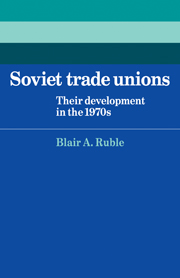Book contents
- Frontmatter
- Contents
- List of tables and figures
- Acknowledgments
- Abbreviations
- Introduction
- 1 Soviet trade union development: 1917–1956
- 2 Soviet trade union development: 1957–1980
- 3 Union–management–Party relations at the plant
- 4 The legal and social rights of Soviet workers
- 5 Do workers participate in Soviet management?
- 6 Patterns of union behavior
- 7 The international activities of Soviet trade unions
- Conclusion
- Notes
- Classified bibliography
- Index
6 - Patterns of union behavior
Published online by Cambridge University Press: 07 October 2011
- Frontmatter
- Contents
- List of tables and figures
- Acknowledgments
- Abbreviations
- Introduction
- 1 Soviet trade union development: 1917–1956
- 2 Soviet trade union development: 1957–1980
- 3 Union–management–Party relations at the plant
- 4 The legal and social rights of Soviet workers
- 5 Do workers participate in Soviet management?
- 6 Patterns of union behavior
- 7 The international activities of Soviet trade unions
- Conclusion
- Notes
- Classified bibliography
- Index
Summary
Soviet trade unions have neither entirely succeeded nor entirely failed in meeting their dual functions. Whether one discusses socialist competition or safety inspections, disputes commissions or health programs, an overall image of union performance is difficult to discern. Certainly there are glowing accounts by Soviet journalists of workers having managers fired; there are also harrowing accounts by Western journalists of managers having workers thrown in jail. If both images are correct – and many of the circumstances underlying such reports appear plausible – how can one make sense of them? What patterns, if any, are evident in union performance? Is it possible to predict when, where, and how a union official will meet his legal obligations? And what are the tensions within the present Soviet system of labor relations that might lead to future changes in union behavior?
The existence of tension within Soviet industrial life should not come as a surprise. Vera Dunham begins an examination of the worker in contemporary Soviet literature by observing:
Alarmingly, Soviet society has long since become not only pluralistic but torn. It is caught up in something resembling a class struggle, wedged between dynamism and stagnation; social mobility and social predestination; centralization and parochialism; metropolitanism and provincialism; overall embourgeoisement that pulls people up and internal colonialism that pushes people down; unifying chauvinism in the improbable all-Soviet recension and the imprudently convincing apartheid, deeply divisive, of the non-Russian nationalities. […]
Information
- Type
- Chapter
- Information
- Soviet Trade UnionsTheir Development in the 1970s, pp. 104 - 118Publisher: Cambridge University PressPrint publication year: 1981
